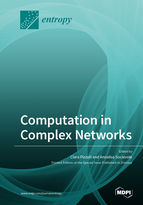Computation in Complex Networks
A special issue of Entropy (ISSN 1099-4300). This special issue belongs to the section "Complexity".
Deadline for manuscript submissions: closed (31 August 2020) | Viewed by 62153
Special Issue Editors
Interests: evolutionary computation; complex network analysis and mining; data mining; data streams
Special Issues, Collections and Topics in MDPI journals
Interests: complex networks; community detection; evolutionary computation; network robustness
Special Issue Information
Dear Colleagues,
Complex networks, in recent years, are increasingly attracting the attention of researchers from many different domains, such as physics, mathematics, biology, medicine, engineering, and computer science, among others. Complex networks are able to model a wide variety of structures that support the functioning of daily life, including high technology networks, the Internet, and communication, chemical, neural, social, political and financial networks. Understanding how complex systems behave is thus an imperative for many different fields due to their interwoven and multidisciplinary nature and inherent complexity.
This Special Issue aims at collecting original and high-quality papers within the research field of complex network computation. When investigating complex systems, several relevant questions arise such as how information/viruses spread, how groups of nodes/diseases form and evolve, and how to detect and improve robustness over their non-trivial topological structure, just to provide some examples. Papers analyzing transportation infrastructures, communication networks, financial networks, political networks, power grid systems, ecosystems, bioinformatics and network medicine aspects are welcome. We also invite papers conceptualizing complex systems through theoretical frameworks.
Prof. Dr. Clara Pizzuti
Dr. Annalisa Socievole
Guest Editors
Manuscript Submission Information
Manuscripts should be submitted online at www.mdpi.com by registering and logging in to this website. Once you are registered, click here to go to the submission form. Manuscripts can be submitted until the deadline. All submissions that pass pre-check are peer-reviewed. Accepted papers will be published continuously in the journal (as soon as accepted) and will be listed together on the special issue website. Research articles, review articles as well as short communications are invited. For planned papers, a title and short abstract (about 100 words) can be sent to the Editorial Office for announcement on this website.
Submitted manuscripts should not have been published previously, nor be under consideration for publication elsewhere (except conference proceedings papers). All manuscripts are thoroughly refereed through a single-blind peer-review process. A guide for authors and other relevant information for submission of manuscripts is available on the Instructions for Authors page. Entropy is an international peer-reviewed open access monthly journal published by MDPI.
Please visit the Instructions for Authors page before submitting a manuscript. The Article Processing Charge (APC) for publication in this open access journal is 2600 CHF (Swiss Francs). Submitted papers should be well formatted and use good English. Authors may use MDPI's English editing service prior to publication or during author revisions.
Keywords
- Community discovery in complex networks
- Motif discovery in complex networks
- Link prediction in complex networks
- Anomaly detection in complex networks
- Complex networks modeling and analysis
- Multilayer, temporal and heterogeneous networks
- Information spreading in complex networks
- Social influence, reputation and trust in complex networks
- Visual representation of complex networks
- Epidemics in complex networks
- Cascading failures in complex networks
- Attack vulnerability, resilience and robustness in complex networks
- Political networks
- Financial networks
- Complex networks for IoT, smart cities and smart grids
- Network medicine
- Mobile complex networks







